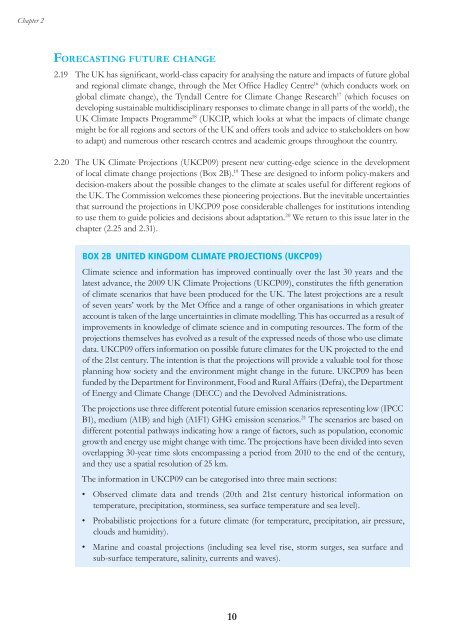Twenty-eighth Report Adapting Institutions to Climate Change Cm ...
Twenty-eighth Report Adapting Institutions to Climate Change Cm ...
Twenty-eighth Report Adapting Institutions to Climate Change Cm ...
You also want an ePaper? Increase the reach of your titles
YUMPU automatically turns print PDFs into web optimized ePapers that Google loves.
Chapter 2<br />
FORECASTING FUTURE CHANGE<br />
2.19<br />
2.20<br />
The UK has significant, world-class capacity for analysing the nature and impacts of future global<br />
and regional climate change, through the Met Office Hadley Centre16 (which conducts work on<br />
global climate change), the Tyndall Centre for <strong>Climate</strong> <strong>Change</strong> Research17 (which focuses on<br />
developing sustainable multidisciplinary responses <strong>to</strong> climate change in all parts of the world), the<br />
UK <strong>Climate</strong> Impacts Programme18 (UKCIP, which looks at what the impacts of climate change<br />
might be for all regions and sec<strong>to</strong>rs of the UK and offers <strong>to</strong>ols and advice <strong>to</strong> stakeholders on how<br />
<strong>to</strong> adapt) and numerous other research centres and academic groups throughout the country.<br />
The UK <strong>Climate</strong> Projections (UKCP09) present new cutting-edge science in the development<br />
of local climate change projections (Box 2B). 19 These are designed <strong>to</strong> inform policy-makers and<br />
decision-makers about the possible changes <strong>to</strong> the climate at scales useful for different regions of<br />
the UK. The Commission welcomes these pioneering projections. But the inevitable uncertainties<br />
that surround the projections in UKCP09 pose considerable challenges for institutions intending<br />
<strong>to</strong> use them <strong>to</strong> guide policies and decisions about adaptation. 20 We return <strong>to</strong> this issue later in the<br />
chapter (2.25 and 2.31).<br />
BOX 2B UNITED KINGDOM CLIMATE PROJECTIONS (UKCP09)<br />
<strong>Climate</strong> science and information has improved continually over the last 30 years and the<br />
latest advance, the 2009 UK <strong>Climate</strong> Projections (UKCP09), constitutes the fifth generation<br />
of climate scenarios that have been produced for the UK. The latest projections are a result<br />
of seven years’ work by the Met Office and a range of other organisations in which greater<br />
account is taken of the large uncertainties in climate modelling. This has occurred as a result of<br />
improvements in knowledge of climate science and in computing resources. The form of the<br />
projections themselves has evolved as a result of the expressed needs of those who use climate<br />
data. UKCP09 offers information on possible future climates for the UK projected <strong>to</strong> the end<br />
of the 21st century. The intention is that the projections will provide a valuable <strong>to</strong>ol for those<br />
planning how society and the environment might change in the future. UKCP09 has been<br />
funded by the Department for Environment, Food and Rural Affairs (Defra), the Department<br />
of Energy and <strong>Climate</strong> <strong>Change</strong> (DECC) and the Devolved Administrations.<br />
The projections use three different potential future emission scenarios representing low (IPCC<br />
B1), medium (A1B) and high (A1F1) GHG emission scenarios. 21 The scenarios are based on<br />
different potential pathways indicating how a range of fac<strong>to</strong>rs, such as population, economic<br />
growth and energy use might change with time. The projections have been divided in<strong>to</strong> seven<br />
overlapping 30-year time slots encompassing a period from 2010 <strong>to</strong> the end of the century,<br />
and they use a spatial resolution of 25 km.<br />
The information in UKCP09 can be categorised in<strong>to</strong> three main sections:<br />
Observed climate data and trends (20th and 21st century his<strong>to</strong>rical information on<br />
temperature, precipitation, s<strong>to</strong>rminess, sea surface temperature and sea level).<br />
Probabilistic projections for a future climate (for temperature, precipitation, air pressure,<br />
clouds and humidity).<br />
Marine and coastal projections (including sea level rise, s<strong>to</strong>rm surges, sea surface and<br />
sub-surface temperature, salinity, currents and waves).<br />
10
















